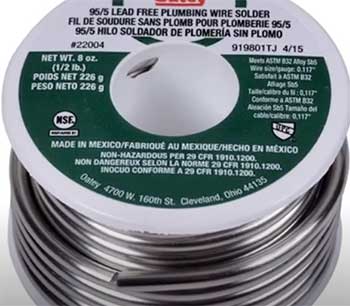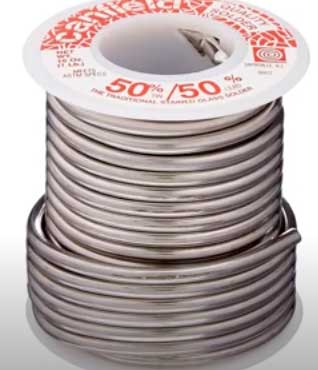Solder wires are commonly used among mechanical, electrical, and plumber workers. They generally use them to joint or bond several electrical connections together. Plumbers also use them for jointing copper pipes.
95/5 and 50/50 solder wires are the two most widely used wires for soldering. But many people are often confused to choose between 95/5 solder vs. 50/50.
Let’s go for an in-depth discussion and help you decide the best one.
A Quick Comparison Table
Are you in a hurry? Then, take a quick glance at both solder wires. This will help you to have a primary idea about them.
| Specification | 95/5 Solder | 50/50 Solder |
| Materials | 95% tin and 5% antimony | 50% tin and 50% lead |
| Melting range | 450°F – 464°F | 361°F – 421°F |
| Ideal to use | Moderate pressures and temperatures | Higher pressures, or where greater joint strength |
| Tensile Strength | 5900 PSI | 6000 PSI |
| Shear Strength | 6200 PSI | 5200 PSI |
| Using options | Potable water applications, refrigeration lines, and cooling equipment. | Automotive, radiator, gutter repair, and electrical applications |
| Safety | Safer | Less safe |
| Durability | More long-lasting | Less durable than 95/5 Solder |
| Price | Relatively expensive. | Cheap. |
In-depth Differences Between 95/5 And 50/50 Solder Wires
So, you have already got a clean sweep idea on both solder wires. Now, it is time to have in-depth details about both options to aid you in selecting the ideal one.
- Materials


95/5 solder wires are mainly made of 95% tin and 5% antimony materials. They don’t contain any lead. Since it has more than 90% tin material, it can provide an excellent lower melting temperature.
This type of solder wire does not produce any poisonous gases when you want to heat them.
They are versatile to work because you can rework or reuse them on a board.
On the other hand, 50/50 Solder Wires feature 50% tin and 50% lead.
They can create strong joint formation between different metals within a short time. You can get effective results from joint copper and nickel-plated steel.
With 50/50 Solder Wires, handling narrow spaces and small holes to flow around is incredibly easy due to excellent wettability.
- Melting Range
The melting range for 95/5 Solder is 450°F to 464°F, which is impressively higher. Hence, they can endure a significant amount of heat.
Things vulnerable to getting a lot of higher temperatures should be bonded with 95/5 solder wires. They will cause minimum damage for the particular objects.
On the contrary, 50/50 Solder wires have a 361°F to 421°F meting range. Thus, you should think twice before using this solder for any items that have more than 350°F temperature.
- Ideal To Use

Before choosing a particular solder wire, knowing their ideal usage is a good rule of thumb. Otherwise, it may lead to hazardous issues.
According to Oatey, 95/5 Solder wires are mainly suitable for areas where higher pressure and greater joint strength are available.
You should aim to use them for items that have frequent, higher temperature alters and vibrations incur.
In contrast, 50/50 Solder wires are more effective for using on things that maintain moderate pressures and temperatures. Their stable temperature and pressure won’t deteriorate the quality of the 50/50 Solder wires.
- Tensile Strength
Tensile strength means the maximum force a particular object can take before breaking down.
Both 95/5 and 50/50 solder wires have almost similar tensile strength.
95/5 solder wires have a 5900 PSI tensile strength, while 50/50 Solder wires feature a 6000 PSI rating.
However, the maximum tensile strength can only be achieved when you keep them at the ideal temperature.
When the temperature comes close to the melting point, their tensile strength will start to reduce. Their endurance capability will drastically reduce.
- Shear Strength
Compared to 50/50 Solder, 95/5 Solder has a better Shear Strength. Since it is made of higher quality material or components, the strength of a material to withstand is impressive.
50/50 Solder has a 6200 PSI rating, while the other one features a 5200 PSI rating. It stands 1000 PSI ahead. They are less prone to get out of their ideal location. This makes them more reliable.
- Using Options

It is important to know where you can use a particular solder wire. Though both solder wires are suitable in various places, 95/5 Solder is more flexible than 50/50 Solder.
You can use 95/5 solder wires, especially potable water systems, refrigeration tubings, and cooling equipment.
Since they meet both Federal and ASTM specifications, you can use all possible items that are safe to use.
On the other hand, 50/50 Solder wires are ideal for using automotive, radiator, gutter repair, roofing, stained glass, electrical applications, and other general purposes.
However, their usability is restricted in many states of the USA. For instance, it is prohibited to use any 50/50 solder wires in Indiana or Pennsylvania.
- Safety
Compared to 50/50, 95/5 solder wires are safer to use. The reason is that they are complied with CA & VT lead content regulations and meet the Government and Plumbing Code standards.
Moreover, 50/50 solder wires have 50% lead, meaning they are highly vulnerable to flame once exposed to air. Hence, you must be cautious while using any 50/50 solder to avoid hazardous situations.
- Durability
95/5 solder are made of high-quality and density-based materials that can withstand a lot of pressure and higher temperature.
Since 50/50 contains a considerable portion of lean, their endurance is not up to the mark. Hence, 95/5 solder wires are more durable than.
- Price
Before I say anything, please keep in mind that the average price I am about to mention is subject to change at anytime.
That being said, the average price of one pound of 95/5 Solder ranges from $40 to $60. And you need to spend around only $20 to $40 for buying one pound of 50/50 solder wires.
Thus, 50/50 is more affordable than 95/5 solder. It is better to select 50/50 on their ideal place when you have a limited budget.
However, please don’t use any 50/50 solder that is not ideal for it. Just because you prefer to cut down costs doesn’t imply you will take a serious risk.
Which Options Appears More Reliable?
Since 95/5 and 50/50 solder wires are two different products, their usability will vary. If you are looking for an affordable and want to use a solder wire only for general purposes, you can go for 50/50 solder wires.
But when a particular item is vulnerable to excessive pressure and higher temperature fluctuations, you want to use 95/5 solder wires. After all, it is safer, more durable, and effective to use.
Frequently Asked Questions (FAQs)
Yes, you can use 95 5 solders in soldering refrigeration tubing and lines since it can handle frequent and extreme temperature fluctuations.
The Tensile Strength of 95/5 solder wires is 5900 PSI, and shear strength is 6200 PSI.
95/5 solder wires generally contain 95% tin and 5% antimony, making them extremely strong to endure higher pressure and temperature.
Generally, the temperature melting range of 95/5 solder wires is 450°F to 464°F, depending on the brand and the process followed to make it.
Conclusion
Compared to solderless connections, soldered connections are more reliable and in different tough conditions. But choosing the accurate solder wire is important.
So, you must know the differences between 95/5 solder vs. 50/50 and where to use them. Only then can you keep the particular connections safe and get a convenient result.
